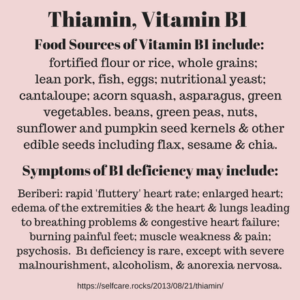Thiamin (also called Thiamine or vitamin B1):
 Food Sources of Thiamin (vitamin B1) include:
Food Sources of Thiamin (vitamin B1) include:
- fortified flour or rice, whole grains;
- lean pork, fish, eggs;
- nutritional yeast;
- cantaloupe;
- acorn squash, asparagus, green vegetables;
- beans, green peas;
- nuts, sunflower and pumpkin seed kernels & other edible seeds including flax, sesame & chia.
Thiamin or vitamin B1 may have been the first vitamin to be discovered.
Thiamin is also known as vitamin B1. Historically it may have been the first vitamin to be discovered. Around 2600 BC the symptoms of thiamin deficiency were described in Chinese literature. Thiamin deficiency, or beriberi as it was commonly called, became a more frequent problem in some communities when white flour and polished rice were first introduced. Milling brown rice removes thiamin from the grain along with the fibrous outer layer of the grains of rice.
Symptoms of Beriberi (Thiamin deficiency) can include:
- rapid ‘fluttery’ heart rate;
- enlarged heart;
- edema or swelling of the extremities,
- heart and lungs leading to breathing problems and eventually congestive heart failure; burning painful feet;
- muscle weakness and pain;
- Wernicke encephalopathy or Korsakoff psychosis are symptoms that may occur with more severe B1 deficiencies and which can include mental changes.
Deficiency of Thiamin is rare except with severe malnourishment or increased needs:
Chronic alcoholics and anorexic or other malnourished people are more at risk for thiamin deficiency. Malaria and HIV may increase need for thiamin due to the infected cell’s increased use of the nutrient. Renal patients on dialysis may need extra thiamin due to increased loss. The nutrient is fairly widely available and deficiencies are not typically found in people of average health with reasonably varied diets.
Reference used for food sources & symptoms of Thiamin deficiency:
- An Evidence-based Approach to Vitamins and Minerals: Health Benefits and Intake Recommendations, 2nd Ed., by J. Higdon & V. Drake, (Thieme, Stuttgart / New York, 2012) [Amazon]
- A description and source for purchasing the text: http://www.thieme.com/books-main/complementary-medicine/product/1040-an-evidence-based-approach-to-vitamins-and-minerals
- A review of the text: http://ajcn.nutrition.org/content/79/5/892.full
- The text is produced in cooperation with the Linus Pauling Institute. He is a researcher who used large doses of vitamin C to cure cancer tumors. His work was met with skepticism. More recently research supports his work in that a specific type of cancer cells is very susceptible to vitamin C – while to the rest of the body it is water soluble and non-toxic at the level that was toxic to the cancer cells. http://www.sciencedirect.com/science/article/pii/S2213231716302634
Additional Reference used for Food Sources of Thiamin:
Disclaimer: Opinions are my own and the information is provided for educational purposes within the guidelines of fair use. While I am a Registered Dietitian this information is not intended to provide individual health guidance. Please see a health professional for individual health care purposes.
